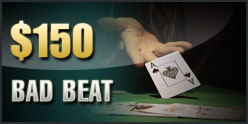Omaha Hi/Low
General Conditions
Omaha Hi/Low follow the same rules as regular Omaha, but there is an additional way to win a share of the pot. The Hi winner is the player with the best poker hand, as in Omaha High Only. But in addition to a Hi winner, there can be a Low winner. The Low hand is a hand with 5 different cards below a 9. You must use two pocket cards and three community cards to make a low hand. For example, 3, 4, 5, 6 and 8 of any suit would be a Low hand. The lowest Low hand is the Low winner. In case of a Low winner, the pot is split 50/50 between the Low and High winner. In case of multiple Low hands, the Low winner is determined by comparing the highest of the low cards, then the second highest, etc. If the two or more Low hands are equal, the Low pot is split between them. Because there must be at least three different low cards (under 9) on the board at the end to enable a qualifying low hand there may not be a Low winner every hand. Also, a player may use different pocket cards for Hi and for Low, from the four cards dealt to him along with any three community cards, where again different cards may be used for the high hand to the low hand. In Hi Low Omaha the lowest possible hand is 5, 4, 3, 2, of any suits (flushes and straights do not count against you for the low hand). Ace counts as high and low and therefore the same ace can be used to make a high hand and a low hand.
Game Rules
Provided below is an outline of a typical game round for limit poker
Blinds: The game begins with blinds being posted by the two players positioned to the left of the dealer's button. This is done before the players receive their cards in order to make sure that the player with the winning hand wins money. On each of the game's rounds, the dealer button rotates its position so that players take turns posting blinds. The small blind is posted by the first player to the left, in the amount of half the minimum stake (e.g. $1 on a $2/$4 game). The big blind is posted by the second player to the left, in the amount equal to the full minimum stake (for example, $2 on a $2/$4 game).
Pocket Cards: The two cards that are dealt face down once the blinds have been posted.
Bet Round 1: The game begins in a clockwise direction. The first bet is placed by the player sitting to the left of the big blind. At this stage, players can opt to either raise, call or fold. The minimum raise amount is equivalent to the table's lower stake (for example, $2 on a $2/$4 game).
The Flop Cards: The three flop cards are placed in the center of the table, face up. The flop cards are also known as community cards because each of the players can choose to use them in their hand.
Bet Round 2: Bets are placed again according to the same rules as the first round.
The Turn Card: At this stage of the game, another community card (the turn card) is placed in the centre of the table, face up.
Bet Round 3: This round, again, is carried out just like the first and the second, with one exception: raising is possible only by the higher table stake ($4 in a $2/$4 game).
The River Card: The river card is the last community card to be placed face up in the center of the table.
Bet Round 4: Bet Round 4
Showdown: This is the final stage of the game where the winning hand is exposed. The pot is given to the player holding the best hand, made up of 5 cards that include various combinations of the two pocket cards and the community cards. If two players have hands of equal value, the pot is divided between them. As part of their playing strategy, players have the option to either show their hand or to Muck which is to fold without showing one's cards.
Start Again: The next game starts with the dealer button moving over one spot to the player on the left.
Betting System: Betting begins in a clockwise direction with the player sitting to the left of the big blind. Players bet according to the winning probability of their pocket cards and the community cards.
Fold: Folding means that you will lose the money that you have already bet or posted in a blind, and that you will be excluded from playing until the next round of the game.
Check/Call: Checking means that you continue in the current betting round with actually placing a bet. Calling means that you place the same bet amount as the player before you.
Bet/Raise/Re-raise: If you're holding a good hand, place a bet. If a bet has been placed by another player, you can raise their bet according to the table stakes. In every round there is one bet and a maximum of three raises or re-raises. The next card is then placed on the table and another betting round begins or the Showdown is reached. All-in: If you wish to continue betting, but do not have enough to call, you can opt to play all-in in order to stay in the game. This allows you to remain in the game and to compete for the main pot. A side pot is set up for players who have continued to place regular bets. The money collected in the side pot cannot be won by an All-in player, even if he has the winning hand at the end of the game.
A Betting round continues until all players have folded or called the third raise, or until a bet has been called by all players (except the one who placed the bet) with no raise taking place.




















